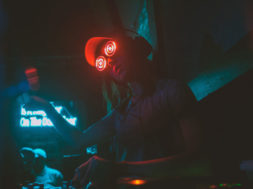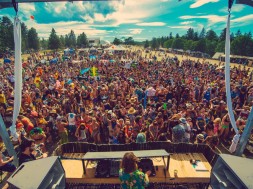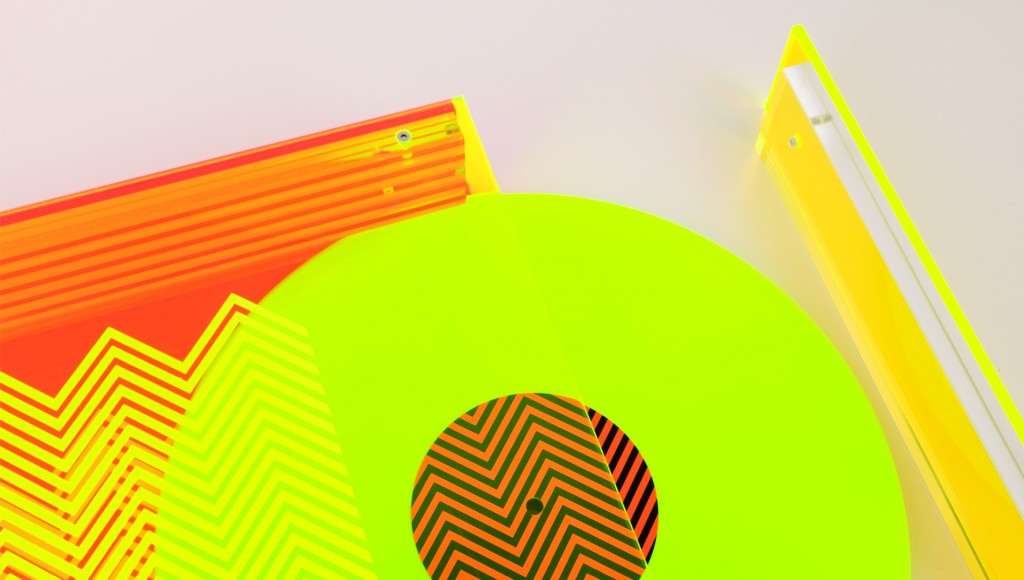
So, you’re an up-and-coming electronic artist trying to make it big.
Where to begin? Create a song with a catchy hook, a bass filled drop, and use some relatable lyrics everyone can sing along to? Done. But, nobody is listening to the track besides your close friends. There is a lack of interest in the song. Despite the catchy title, everyone seems to be scrolling right passed it. How will you get people to listen to your music? Why not just use the music from a popular song, the part of “that one song” everybody knows, and then mix in your own track? That’s what everybody else does. What do you have to lose?
Just as you suspected, your song starts to gain popularity on SoundCloud. The song you used is number one on iTunes, so people are hungry to hear remixes. Yours is the best right now, and it has 46,000 plays! “This is awesome,” you think. But, a few days later you check back up on the song and it’s gone. There’s an email from SoundCloud saying that your track was taken down for copyright infringement. “We have received notice that your account contains the use of a work without permission from the original creator. We have removed and disabled access to the material,” you read, defeated. But don’t worry too much. Ever heard of Led Zeppelin? Ed Sheeran? Madonna? They’re right there with you.
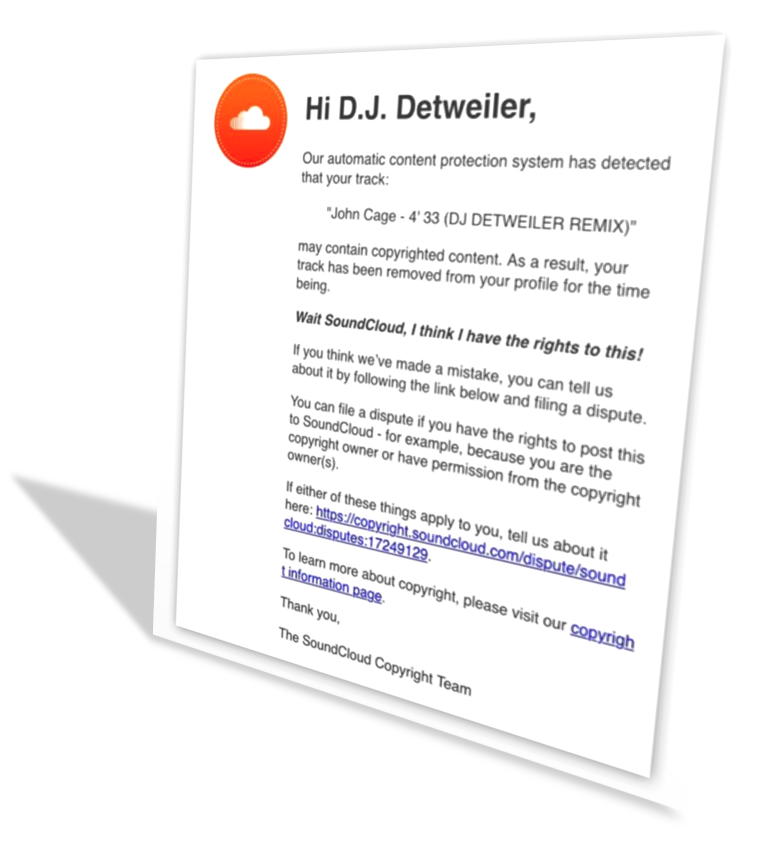
What exactly made SoundCloud give you that notice?
What is copyright infringement, anyways?
Copyright law, within the United States, protects “original works of authorship,” fixed in a tangible medium and includes literary, dramatic, musical, artistic, and other intellectual works. This protection is available to both published and unpublished works. The first ever copyright law was developed in 1909, stating that an author had the right to a 28-year term for the work plus another 28 years if the song was registered with the Library of Congress. Later, in 1976, the government started to make some relevant changes. The 1976 Copyright Act states that you as the creator have full rights to your work for life plus 50 years if it is represented in a fixed, tangible property of expression. The act also stated that registration is no longer required, but you must give notice of your work.
Today, we are living within the “greyest” area regarding copyright infringement that the music industry has ever been through.
This is solely due to the highly advanced level of technology we are treated to as creators and innovators.The Digital Millennium Copyright Act, DMCA, is a copyright law that provides a “safe harbor” for Internet service providers, absolving them of liability for infringements committed by their users on the network as long as the ISP followed the guidelines set by the law. This is relevant today, due to the important role the Internet plays in the daily lives of humans. But, all of this being said, if you break copyright within the present day (depending on who you are of course), I wouldn’t get too worried yet.
If everybody is doing it, why is it illegal?
“Most sample-based artists have uncleared samples in every single song they produce. People trying to start from the bottom don’t contact the bands. They would likely want thousands of dollars for the use of the song, and even then they may not even give us the rights at all,” a producer from Colorado stated.
Sometimes, the worst that will happen to you is that you’ll be notified to take the track down or disable the “free download” feature. Since the likelihood of anything negative happening is pretty low due to their lack of popularity, smaller name producers and artists risk it and use unoriginal samples. They think, “Make an awesome track, use some popular samples, if it gets big I’ll go from there. If it doesn’t, at least the music received some attention.” In opposition to this, big name producers and artists “usually” seek permission for the use of unoriginal work. Their work will definitely be getting over 50,000 plays and receive a wide range of attention. It’s understandable why the up and comers try to make their name heard by using unoriginal work, but it is still illegal.
Sometimes, in yet another situation, a label owned by a big name artist will approach an up-and-comer that has gained some popularity and ask them to remix one of their tracks. Are you starting to see a grey area trend beginning to form here? There are many twists and turns that go case by case within the industry. This scenario, however, is pretty beneficial for the new guys. The label or artist will say that they like the up-and-comer’s style, and seek to discover their creative potential. By asking the up-and-comer to do a remix of one of the label’s own tracks, the big name artist will be able to dive in and dissect what was changed and newly created. The new sound as a whole will be one aspect for consideration, but the knowledge and level of intelligence during the creative process is just as, if not more, important. It will not go unnoticed by this more “advanced” artist. If you’ve ever heard of deadmau5 and his protégé, Rezz, they are a great example of a big name taking an up-and-comer under their wing.
You may be thinking, “Isn’t the point of a remix to change the original sound, anyways?” And you’d be right. Remixes are a way for the artist to explore their niche, their genre, and develop their personal flavor. Manipulation and transposition of material from the unoriginal sample in order to create a new, personal sound is how remixing is generally approached by the producer. By manipulating certain aspects of the track, the producer can do anything from changing the tempo, changing the pitch, to transposing the vocals or creating new ones. When this new sound is created, the producer’s personal style will be reflected in the track. Without having your own “personal flavor” or “signature sound,” you will not be noticed. There are so many producers out there today creating the same type of sounds, so creating one that is unique, stand out, and different is the first step.
Want to create your own track? Here’s how.
Russ Liquid, a funky musician from New Orleans and founder of the Russ Liquid Test, explained from experience that the electronic music industry has reached a low point. Some bigger name producers, well- the lazy ones- will take a melody or part of a song from a smaller artist recently gaining popularity and put it into their sets, claiming it’s their own track. Instead of simply giving the original artist credit, or paying them for the use of their work, they brush it off and act like they’re entitled to use whatever content they want.
“You send them your unreleased songs for some feedback, maybe some editing help. Then, you hear that they played it in their show three days later. Some of these people claim to be our friends, but they just care about the money. We don’t receive credit or compensation, and our fans don’t know that that’s actually our song.”
But, up and coming artists, don’t lose all hope yet. Not all producers are big bad wolves. Big names such as Bassnectar and Griz make it a point to ask permission for the use of unoriginal content, and in turn, compensate the owner. “We have so much more respect for people like Grant (Griz). Just because you’re at the top, doesn’t make it right to take music from others,” Russ says.
Ed Sheeran, the multiple Grammy award winner with the voice of an angel, has had his fair share with lawsuits involving copyright infringement. Surprising, right? One of his most popular songs, “Thinking Out Loud,” was accused of using key elements from Marvin Gaye’s “Let’s Get It On.” The heirs and cowriter of the popular mood-setting track attacked Sheeran, accusing him of stealing the harmonic progressions and melodic and rhythmic elements that are key to the song. Only months before this lawsuit, Sheeran had been sued for over $20 million in compensation for plagiarizing another work, his song “Photograph.” When it comes to the concept of money, the industry is as relentless as Chicago’s parking enforcement.
Ed Wimp, author and manager to bands like Earth, Wind & Fire, explained the process the smaller names go through when sending out an infringement notice to a big name. Wiz Khalifa’s former bass player, Jonny Good, had a falling out with Khalifa after a life long friendship. After the breakup, Khalifa copied one of Jonny’s verses onto his track, “My Momma.” Good sent Khalifa a copyright infringement notice and ended up settling. So, how do you decide if a case is worth pursuing? How do you know if you will end up with less than you started out with? If Wimp and Good hadn’t taken the settlement offer, they could have tried to sue for payment per song sold. However, Khalifa’s lawyers were strong, and he had more money to put into the case. In situations like these, accepting the settlement is the best option when looking at all of the possibilities.
What about these lawyers? What exactly do they do in the world of copyright infringement, and what makes a strong one? What makes a lawyer the “best” one? From sleeping on hardwood floors to opening up for Jefferson Starship and living a fearless life on the road in between, Peter Strand knows the music industry like he knows the strings of his bass guitar. He’s lived as a band member through the whirlwind of the late 1970s, earned a spot in the Wisconsin Area Music Industry Hall of Fame, and has become the best entertainment lawyer in Chicago because he simply “wanted to.”
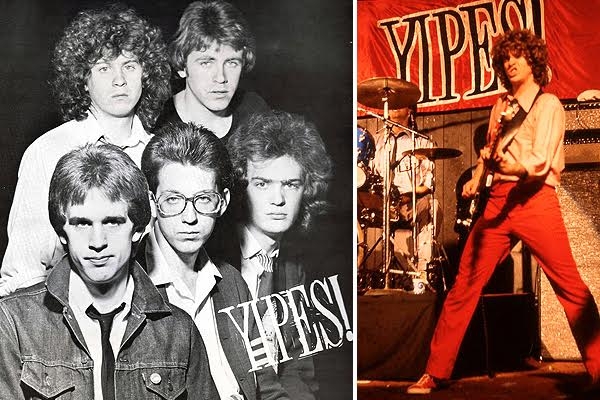
Strand featured here rocking out and posing with his band, “Yipes!”
Strand encounters a variety of work from day to day. His long list of services combined with his easy going, yet disciplined attitude strongly contributes to his title of “Lawyer of the Year.” Strand reviews reality contracts for on-screen participants finds publishing deals for recording artists, songwriters, and producers establishes transactions between artists and managers and works with trademarks, branding, copyright registration and enforcement. Other tasks the office takes on include working with television deals, documentary films, feature films, and children’s books, to name a few.
Copyright law, originating within the Constitution, has become one of the biggest problems or grey areas within the electronic music scene today. Exclusive rights are given to artists and creators for their work for life plus 70 years. However, even though artists and creators have these exclusive rights, advanced technology has made it easy to steal a piece of work and pull it off as one’s own. That’s where Strand and his team come in. “One of the biggest problems in the industry today is that technology has made it so easy to capture and manipulate other people’s work. There still remains, even though we are 20 years into the digital age, this notion that if it’s online, it’s free to be taken. That’s just not true,” Strand explains.
Leavens, Strand, and Glover advise their clients to create a sound that sounds similar to the sample they are interested in, instead of taking and editing the original sample itself. When clients present their case to Strand, he has a personal checklist he likes to refer to.
“First, we ask the client if they have registered a copyright of the work with the Library of Congress Copyright Office. That’s the necessary step to filing a lawsuit under the copyright act. Next, if it’s a piece of music, we’ll play the original side by side to the new piece to see if they’re similar. We’ll do anything from contacting their team asking them to remove the song, to calling in a trained music theory expert to compare the songs. The last move is to see if the artist distributed the song. If not, then there was technically no access to the track, and it must be removed.”
So, is there a way that you can use an unoriginal piece of music within your own track?
By seeking the permission from the band or artists, different potential situations can be created. If you are not trying to sell the music, artists are more lenient with its use, because it provides attention for them and they aren’t losing any money. If you are trying to earn a profit through the use of their song, they will request the profits. JR Schramm, a local Chicago producer who goes by the name of Statik, remixed a song from a band called “The Monophonics.” He reached out to the band, and they came to a “no sale” agreement, meaning that he could include the remix on his album as long as the track was not for sale.
What else can you do besides seeking permission? Have you ever been looking on SoundCloud and noticed a circle with a CC next to the artist’s name? That’s a Creative Commons license.
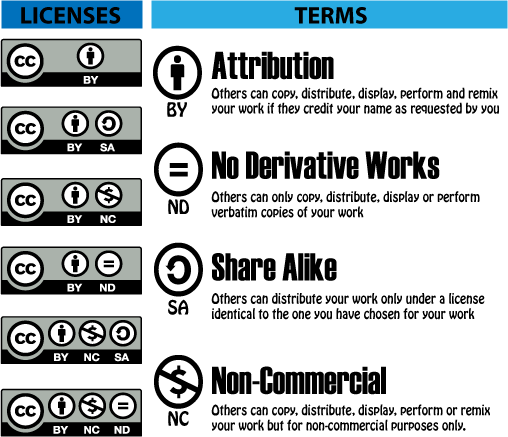
If you’ve never seen that before, I’ll tell you all about it. Basically, a Creative Commons license is one of many different public copyright licenses. They enable the free distribution of what would have otherwise been a copyrighted work, inaccessible for public reproduction and distribution. The “commons” refer to the body of work that is available for the public for free and legal sharing, use, repurposing, and… remixing! So, when an artist wants to give people the right to use the track, share it, edit it, cut it, build on it, whatever, they’ll give it a Creative Commons license. How nice of them!
Creative Commons is a nonprofit organization that “enables the sharing and use of creativity and knowledge through free legal tools. The free, easy-to-use copyright licenses provide a simple, standardized way to give the public permission to share and use your creative work- on conditions of your choice.”
What if you’re not an artist or a producer and you want to use a song? Let’s say that this time, you’re a videographer working video coverage at a live event. You already have the perfect song for the video. You even bought the song on iTunes to make sure you weren’t “stealing” it. You get all of your footage and head home to create the recap. Content with your work, you post the video on your popular YouTube channel to share with your followers. Yet, despite how awesome the video is, you get a notice from the band for copyright infringement. Depending on how some artists license their music, a few things can happen in this situation. An artist can allow the use of their song, free of charge, but in return for credit, an artist can allow the use of their song if they receive all profits and revenue from the YouTube ads, or an artist can deny the use of their work, and the video gets removed.
The world of YouTube is a messy one regarding copyright. There are so many thousands of videos added each day, that it becomes hard for an artist to efficiently keep track of their work. Ben Schuller, an artist, and songwriter from Detroit, stumbled upon a video with over 10 million views. Upon listening to the audio, he realized that he was listening to his own song. The title was different, and the melody was changed. However, Schuller was the original creator. The video got a few views, but nothing big. When he saw the viral video and the amount of money the teenage singer was earning, Schuller filed a copyright claim with the network.
“I told YouTube that I owned the rights to the song, and he tried to fight it. 12 million views is equivalent to around $12,000, so he tried pretty hard to win the case. Lucky for me, they rejected his appeal. If anything, I guess it gave me a few extra fans I wouldn’t have had otherwise, but the kid’s channel got a ton of traction from my work. He has around 100 thousand subscribers now. YouTube is a weird place,” Schuller explained.
The original track by Schuller, “Need This Feeling”
Track used with visuals from a video game series, FNAF
More often than not, YouTube account users do not own all of the rights to their content. Users can monetize their video, which leads to problems with copyright infringement if someone is gaining revenue from content that is not rightfully theirs. However, like the smaller name artists using big name work, unless you are receiving thousands of views or collecting revenue, the video might go unnoticed by the owner.
Where did this all of this crazy stuff start from anyways?
Well, the event that kicked off the slippery slope happened in 2001, when A&M Records sued Napster, the peer-to-peer file-sharing Internet service. Do you remember coming home from school and logging onto programs like LimeWire, Bearshare, or any other bootleg music website you and your friends enjoyed? You know, the digital audio sharing programs that your parents told you not to use because they would download hundreds of viruses onto the database and crash the computer daily? These programs enabled users to upload MP3 formatted content and share it with other users. More often than not, the quality would be terrible or it would take forever to download. Sometimes, you’d find a diamond in the rough and rock out for an hour straight to songs like “Stacy’s Mom” with your friends.
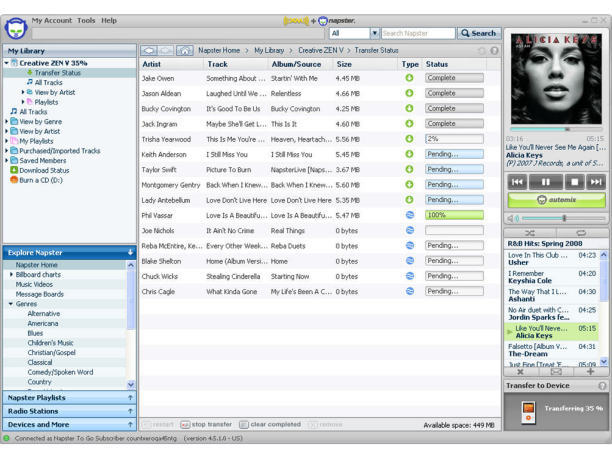
Napster was the original program that hit the scene in 1999 but didn’t even last two years before legal action was taken against it. At the time of the lawsuit, the program had around 25 million registered users. Napster made is easy for music lovers to download copies of songs that were otherwise pretty difficult to obtain unless you went out and bought the physical CD the song could be found on. Ah, those were the days. Colleges blocked the programs, with 61% of external network traffic consisting of MP3 file transfers. It’s pretty funny to think about the “struggle” back then, when today, we simply open an app on our cell phones to listen to any song we’d like.
Originally, according to an article released through Napster, the problem started out when Metallica heard that one of their unreleased songs was circulating throughout the program. Radio stations soon got ahold of it, alerting the band that the “entire back catalogue of studio material” was also in the hands of the 25 million registered users. Dr. Dre later became involved with regards of the same problem, and the two came together to deliver thousands of names, the main “pirates” of the music, to Napster. A&M Records, along with many other recording companies, sued the music-sharing program on the grounds of “contributory and vicarious copyright infringement under the US Digital Millennium Copyright Act (remember that?). They were faced with these allegations:
- Napster’s users were directly violating the plaintiffs’ copyrights.
- Napster was responsible for contributory infringement of the plaintiffs’ copyrights.
- Napster was responsible for vicarious infringement of the plaintiffs’ copyrights.
Napster lost the case and was commanded to keep track of the activities of its network and restrict access to infringing material when informed of the material’s location. Of course, with millions of users, they were not able to comply and closed down shortly after the lawsuit.
Hopefully, you’ve learned a little bit about the industry and how things like copyright work. If you’re still a little confused, don’t worry. We’re still trying to understand certain parts of it too. If there were problems involving lawsuits 16 years ago, think of the problems we’ll have as technology continues to grow and becomes smarter than it already is. But, humans will (hopefully) get smarter too. If we haven’t figured out a way to keep everything fair and legal within the next few years, we’ll cross that bridge when we get to it.
128



